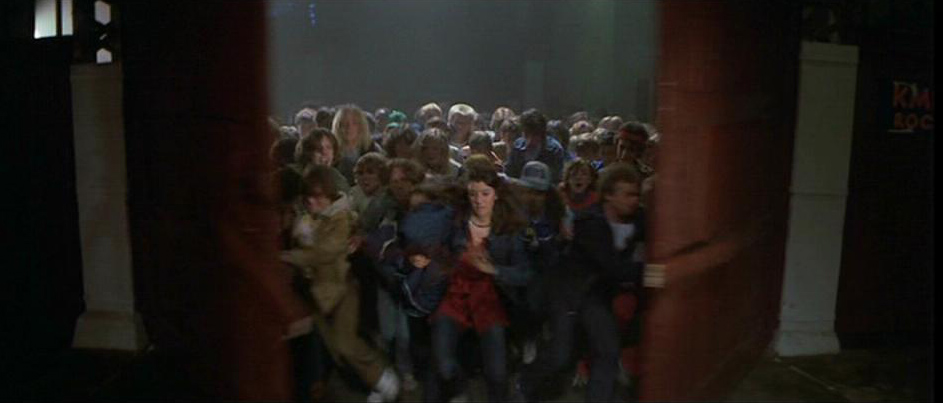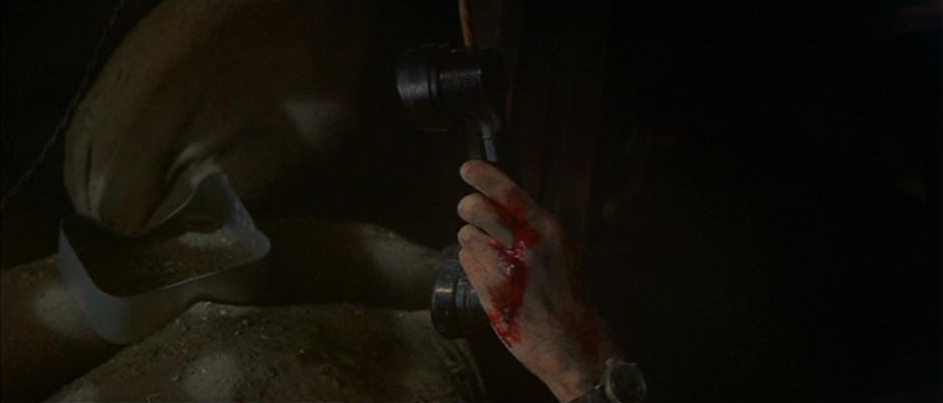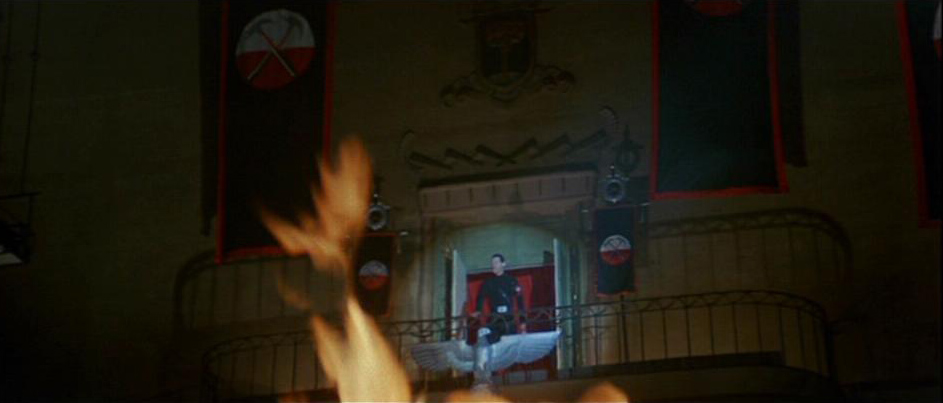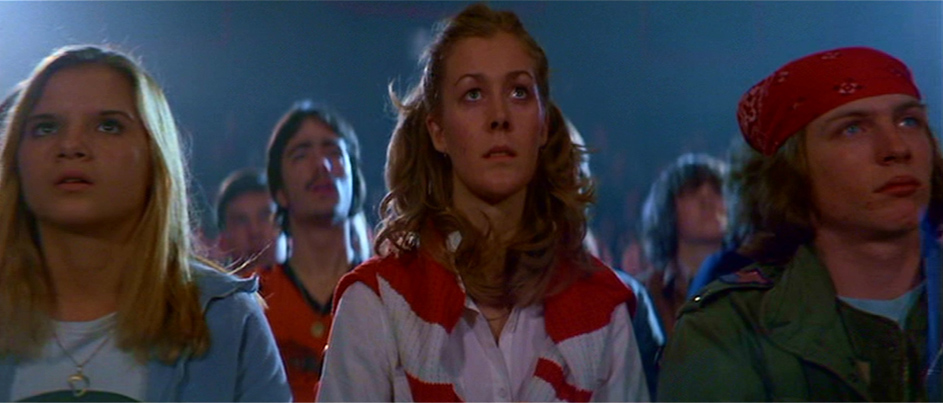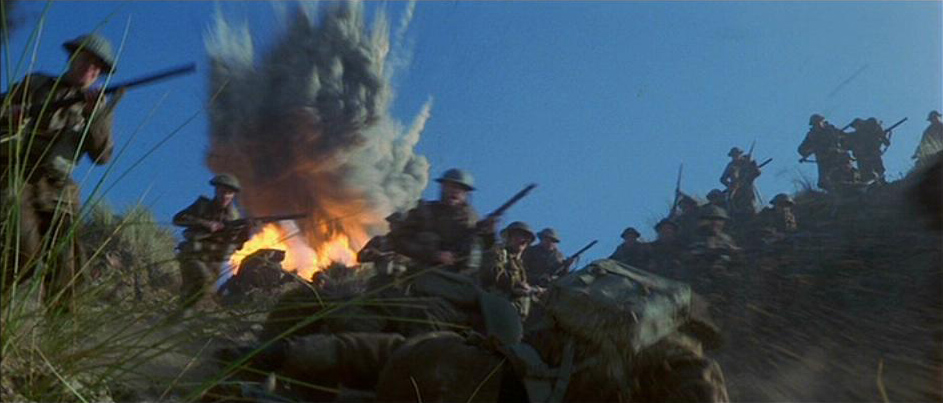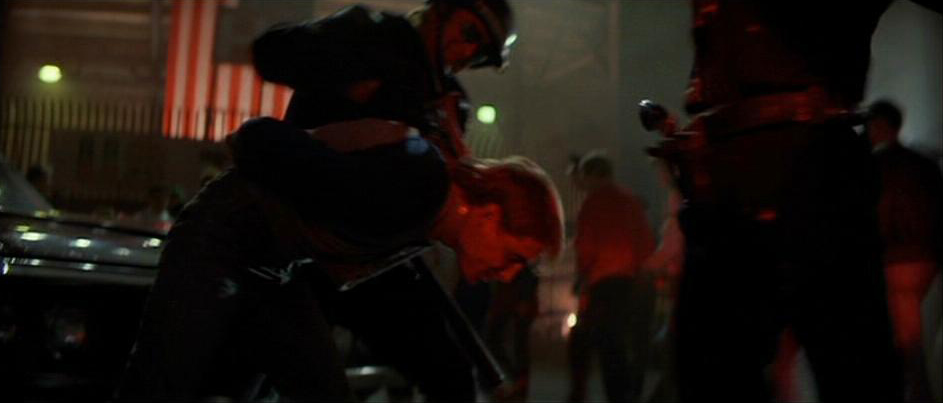In The Flesh?
[album: Roger Waters / film: Bob Geldof]So ya thought ya
Might like to go to the show
To feel the warm thrill of confusion,
That space cadet glow.
Tell me, is something eluding you, sunshine?
Is this not what you expected to see?
If you wanna find out what's behind these cold eyes
You'll just have to claw your way through this disguise.
Lights!
Roll the sound effects!
Action!
Drop it on 'em!
DROP IT ON 'EM!
Song In A Sentence:
Paralleling his own conception and birth into life as well as the narrative, Pink invites the audience at one of his rock concerts (and by extension, us the listener) to delve into his story.

U nlike the movie’s rather calm introduction into Pink’s life, the album begins with as much thunder and lightning as the “Let there be light” of Genesis. The pounding guitars, monstrous organ, and heavy bass and drums flood the listener in aural spectacle, propelling the audience into the story without a preparatory breath…or so one might think. Actually, those with attentive ears will notice a little 15 second prelude to “In the Flesh?” in the form of background music and a quick, nearly imperceptible voice. The music is from the ending of “Outside the Wall,” the last song on the album, and the spoken message is “…we came in?” Put on some headphones, crank up the volume and you’ll find the message’s first half at the very end of “Outside the Wall”: “Isn’t this where…” Isn’t this where we came in? Ardent fans of Pink Floyd will have no doubt already noticed cycles appearing through all of the band’s Waters-driven albums. To name a few of the more obvious ones, Dark Side of the Moon begins and ends with the same slow heartbeat; Wish You Were Here begins and ends with two different versions the song “Shine On You Crazy Diamond”; similarly, Animals begins and ends with “Pigs On the Wing” parts 1 and 2; subsequently, The Final Cut‘s “Two Suns in the Sunset” fades out on the same road noise and radio chatter that introduced “The Post-War Dream”. As mentioned before, these are just a few of the more obvious cycles found in Pink Floyd’s catalog, more of which includes shared guitar riffs, rhythms, lyrical allusions and themes.
So why the disjointed message here? The story of The Wall is a fairly universal tale not limited to the war babies – those who grew up feeling the first-hand effects of World War II. Though it’s about the fictional character Pink specifically, and Roger Waters himself in a quasi-autobiographical sense, one can argue that it’s also a metaphorical story of Everyman, portraying events and emotional states (albeit, in the extreme) that nearly all of us can personally relate to in some ways. Pink’s tale is one about death and life, both of which are ever-present and neverending. As much as he created many of his emotional bricks, many were inherited from previous generations (his father, his mother, his teacher, his country, etc.), who, previously, had inherited some of their own bricks from generations prior, and so on. Similarly, when Pink’s wall comes down, the children in “Outside the Wall” collect the bricks, possibly using them to build their own walls, and thus restarting the cycle with “In the Flesh?” And so while Pink’s specific story has a beginning, middle and an end, the overarching metaphor of the Wall, as it applies to both the individual and society, is cyclical, starting over with each new generation…just as it does with Pink at the very moment of his literal and symbolic conception in “In the Flesh?”
As for the message itself, one doesn’t actually know it’s a question judging by the part at the beginning of “In the Flesh?” We simply know that this is where “…we came in,” a possible allusion to Pink’s lament at the end of the album in “the Trial”: “There must have been a door there in the wall, when I came in.” After repeated listenings, the listener realizes that the door Pink longs for to escape is the very one we used to come in and get a peek behind his wall.
Various Floyd fans have often expressed a certain amount of confusion about the first “In the Flesh?”, a little puzzled by everything from the somewhat esoteric lyrics to the question mark in the title. And rightly so. Rather than holding the audience’s hand as they slowly guide us into the Wall’s depths, the Floyd throw us straight into the deep end with “In the Flesh?”, choosing to start the story (at least interms of the album and concerts) with one of the more narratively and metaphorically complicated songs on the entire album. And rightly so. Considering that the album’s first song is largely about conception and birth on multiple levels, what better way to convey the chaos and confusion that is the beginning of life than with an equally chaotic and confusing opening song?
Nearly every song on the Wall pulls interpretive double duty in the sense their lyrics are equally relevent to the individual as well as broader social and universal themes. The lyrical themes of Pink’s personal story dovetail nicely with the larger social themes of war, nationalism, and what it means in the grand sense to be human. As if there weren’t enough levels of interpretation already, “In the Flesh?” compounds things by offering three different birthing transitions within Pink’s narrative alone. That is to say, the lyrics of this one song can be interpreted on three different levels within Pink’s life story.
Narrative level #1.) The song acts as a poetic representation of young Pink’s actual conception and birth in 1943. By this interpretation, the lyrics act as instructions for the soon-to-be-born child from an unspecified speaker – whether God, Pink’s parents, or Life itself. The message sets up the theme of expectation and disappointment, as already addressed in the film’s lyrical opening with “The Little Boy That Santa Claus Forgot.” The unborn child wanting to “go to the show” (a metaphor for life) expects to feel the warmth of love and acceptance from the world, but will most certainly be disappointed when that love eludes him, replaced by a world teeming with “cold eyes” and “disguise(s).” Although the song doesn’t introduce the metaphor of the Wall, it does prepare the child for a world of wall-like disguises that can only be torn down by “claw[ing],” implying that violence, not love, is the way of the world. In the film, this message of violence is heralded both by images of the concert-goers being beaten by the police cleverly cross-cut with grisly images of young adults of roughly the same age being shot and blown up on the battlefield. Similarly, the movie ingeniously alludes to little Pink’s conception with the images of the rushing mob at one of his future rock concerts. The countless young concert-goers bursting through the doors, hindered by obstacles like the police before reaching their destination – the coveted inner room of the concert house – perfectly parallels procreative sperm obstructed by the body’s natural defenses before reaching the egg. The title itself with that peculiar question mark also suggests the theme of conception, suggesting that a physical body has not been formed yet…that there is still potential either way towards birth or miscarriage. Pink’s birth is arranged as the Speaker yells for “lights,” “sound effects,” and “action,” further equating “the show” with life, much like Shakespeare’s Jaques in As You Like It comparing life to a play and every person an actor on the stage. On that same timeline, the final “Drop it on ’em!” and the airplane dropping a bomb introduces Pink’s birth as well as his first brick, the death of his father.
Narrative level #2.) The song introduces us to adult Pink, “birthing” him, so to speak, into the narrative. On this level, Pink is performing at one of his concerts, and is himself nearly encased by his wall. His sings to his audience, almost taunting them from behind his wall, behind his “disguise” and “cold eyes.” In rhetorically asking “Is this not what you expected to see,” he again sets up those same aforementioned themes of expectation and disappointment, and in a way blames them for the deluded person he’s become. In an autobiographical sense, the Pink of this narrative level is much akin to the Roger Waters during the band’s “In the Flesh” tour, personally guarded against those in the seats and nearly believing himself to be the demigod figure they want him to be. (More on this in a few paragraphs.) If one is inclined towards this narrative interpretation, then the Wall shares a literary characteristic common to most traditional epic works including Homer’s Odyssey and Vergil’s Aeneid – in media res, or starting “in the middle of things.” This technique has been used for ages to immediately grab the audience’s attention, forcing them to accept the current situation at face value before revealing the backstory via flashbacks. In this way we are introduced to Pink at his lowest before almost immediately glimpsing him at his most innocent, as alluded to in the baby’s cries at the end of the song. This juxtaposition of jaded Pink and the cries of a newborn Pink not only creates a narrative tension between the polar opposite of personas, but makes us, the audience, all the more eager to find out just how he transformed from “Baby Blue” to cynical, frightful dictator before us.
Narrative level #3.) The concert of this first “In the Flesh?” takes place after Pink’s wall has come down. Cynical though it is, Pink’s sermon to his crowd is, in many ways, instructional, spoken as if by someone who’s lived through the worst of it and is now out on the other side, offering his honest-albeit-jaded opinion about the cold, hard reality of walls and life in general. His audience thought they were coming to the concert to feel that “space cadet glow” (a phrase evocative of being stoned, something many a Floyd fan knows a few things about), but instead are treated to their hardened idol’s lessons about reality. Talk about a buzz kill. If this third narrative timeline is indeed valid, then this technique of starting at the end of the story (in termini res?) has literary precedence, as well – most notably in Samuel Taylor Coleridge’s epic Rime of the Ancient Mariner. Coleridge’s poem begins after all of the major action of protagonist’s story has taken place, offering a juxtaposition between the world-weary, slighly lunatic Mariner with his former naive self. It’s only as the Mariner tells his story to an unwitting passerby that we, the reader, start to piece together just what he’s been through. Through long flashbacks, we find that the Mariner has lived through hell-on-earth – much of which was (arguably) self-created – and has made it to the other side, but only after embracing his darker self by taking responsibility for his own actions (at least according to one interpretation). Though you might think that the Mariner would have a new lease on life after coming as close to death as you possibly can, his present-day self, though more self-realized, is a conflicted character. He is at once grateful for what he has learned, haunted by his past experiences, and seemingly involuntarily obsessed with spreading his message to a public who humor him for a time, but clearly have better places to be. A similar narrative framework might be interpreted withinthe Wall, with the Pink of “In the Flesh?” in the role of a modern Mariner. He has lived through the destruction of his wall, and has become a self-actualized prophet of sorts constantly torn between a hard-won wisdom and the ghosts that haunt his dreams. He is compelled to tell his story to anyone who will listen – namely, his audience – instructing the innocent “sunshine(s)” on what he’s found to be the truly dark nature of reality – “cold eyes” and “disguise(s).” Note that in the movie sequence for the song, Pink’s eyebrows are already shaved off…something that he doesn’t do until the second half of the film, giving further credence to the idea that “In the Flesh?” is Pink’s rebirth into the world after his wall has come down.
Interestingly, all of the original ideas and emotions that spawned the original concept of the Wall are buried within “In the Flesh?” The song title itself is taken from the band’s “In the Flesh” tour of 1977 promoting their Animals album. On the DVD commentary, Waters comments that the police and riot scenes are inspired by true events which took place on that tour, most notably an incident in Los Angeles when a local police chief attacked “rock and roll in general” because he was upset that there was to be a rock show in a downtown sports arena. The police apparently beat many fans at the venue, searched everyone with a ticket, and made numerous arrests, all for the sake of “order.” The original spark, though, is recreated in the images and lyrics of “In the Flesh?” when Pink, in the role of demigod, dictates a set of instructions and clues to the blank-faced, “mindless” audience. Pink’s balcony performance is reminiscent of the way gods and other supernatural entities are often portrayed in theatrical productions, usually on a balcony overlooking the action of a play, both observant and detached from the world. Such is the very feeling that produced the idea of the Wall in Roger Waters’ mind during the 1977 “In the Flesh” tour. On numerous occasions, Waters has recalled the feeling of standing on stage while audience members either got drunk and started brawls with one another or stared up at him and the rest of the band as if they were gods rather than mere mortal musicians. These observances made Waters feel completely detached from his audience and the world, eventually causing him to take on the godlike persona that his audience was placing on him, resulting in the infamous spitting incident in which Waters spat on a fan who was climbing the security netting separating the audience from the stage. In the liner notes of the Is There Anybody Out There CD, Waters recalls being immediately shocked by his actions, saying “I realised that what had once beeen a worthwhile and manageable exchange between us (the band) and them (the audience) had been utterly perverted by scale, corporate avarice and ego…I had a very vivid image of an audience being bombed – of bombs being lobbed from the stage – and a sense that those people getting blown to bits would go absolutely wild with glee at being at the centre of the action.” Waters was obviously horrified both by his own actions and the idea of an audience so blindly obedient to the idea of celebrity that they would gladly be “blown to bits”…or even spit upon.
The juxtaposed shots of the concert-goers being brutally handled and the soldiers who appear to be roughly the same age as Pink’s audience signal a birth in the metaphorical narrative, that of the world coming out of World War II . Whereas the Allied soldiers fought a centralized enemy, the kids in the present must fight the world devastated by the war. The postmodern fragmentation stemming from the world’s loss of a nostalgically imagined innocence can be seen in many forms during “In the Flesh?”: the brutal force used by supposedly civil protection, the brain-washed look of the audience trained by social norms to humble themselves in front of demigod rock stars, and the commercialization of the “Feelin’ 7-UP” billboard looming godlike over the crowd outside the venue. Even the American flag, that iconic symbol of country under which so many soldiers have fought and died, sits static and aloof over the scene of generational violence. It’s a disjointed world that tries to fill the void of personal meaning with reverence for corporate products and celebrities; a postmodern world introduced by Hitler’s campaigns and the total devastation of the firmly-rooted familial and social milieu. While the world’s population increased with the baby boomer generation, many in that generation feel that humankind never regained its sense of purity and innocence, arguably corrupted with WWI and the birth of Modernism and fully shattered with the Second World War.
And yet out of the multiple planes of narrative and various thematic threads comes a single sound of hope, that of a new life being born. Yet leave it to Waters and company to let this hope be shortlived, for even as the child cries and breathes his first breath, we already know the weight of the mental bricks that loom like fate over this innocent child. We’ve heard the planes fly, listened to the bombs fall, seen the father die, watched as his hand slipped slowly from the telephone – that most symbolic of instruments of communication – as he was calling for help. (Not mere coincidence, either, considering that more than a few of Pink’s bricks were formed by a gross lack of communication on his part.) Like some Greek tragedy, the infant cries, the father dies, and we,the audience, knowing everything that Pink will become, take these disparate fragments and begin to piece together the Wall he is destined to build.
What Other Floydians Have Said
"[If 'In the Flesh?' takes place, chronologically, after the second 'In the Flesh' and the destruction of his wall, then] Pink's use of the song is reminiscent of the end of The Great Dictator, where Adenoid Hynkel gives a ranting, Hitleresque speech that implores people to put their differences aside and work together to get things done. Pink's doing the same thing here: where he once used a song to promote differences, he now urges people to end the fighting and think before they build a wall." - Nick
"During In The Flesh? the plane that drops the bomb on Pink's father was nicknamed 'The Trumpets Of Jericho.' Because that shriek was unique to that plane and it scared the shit out of everyone on the battlefield. Now, the story of the walls of Jericho are simply that a siege was going on against Jericho (i think-i'm not exactly religious) and that only Trumpets brought down the wall. It doesn't make sense to suggest that the death of Pink's father will bring down his eventual wall (the opposite is true) but maybe its a foreshadowing of the trial. No bombardment but only the shouting of the judge will bring down his wall. That sounds logical to me." - Phil Rutland
"An interesting observation regarding that [7-UP] billboard, made possible by my love of baseball and residence in the city of Philadelphia, PA, is recognizing the figure pictured there as Mike Schmidt, a Hall-of-Fame baseball player for the Phillies. The key here being Philadelphia, also known as, yes... you guessed it, the “City of Brotherly Love.” Its juxtaposition against the chaos and violence that is breaking out all around may or may not be intentional but I found it quite interesting nonetheless." - Mark Ragonesi


